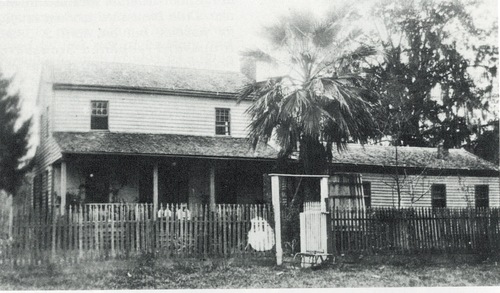.JPG)
Stores Followed Frontier Settlers
By Judith Linsley
Not far behind the first settlers to Texas came the first merchants, who quickly opened for business in the tiny frontier settlements that sprang up.
During the days of the Republic of Texas, Beaumont, on the Neches River, was tiny compared to the trade centers of Galveston, San Antonio, and Houston. One 1835 estimate gave it only 90 residents and 12 homes. Even then two stores served the citizens-Pulsifer and Company, and one owned by a man named Rogers.
Pulsifer and Company, located in what is now the Charlton-Pollard neighborhood, was a one-room log structure, yet the firm carried a wide range of merchandise, including wine and medical supplies. Joseph Pulsifer, one of the owners, made occasional trips to New Orleans to replenish inventory. As a trained pharmacist, he got numerous requests for medical treatment, such as the letter from a Liberty man asking "Dr. Pulsifer" for a hernia truss for his small son.
The store eventually moved into a larger building farther upstream, and in the 1840s D.J.O. Millard, Henry's brother, bought the business.
By 1850 the total population of Jefferson County was 2007, and Beaumont and Sabine Pass had become busy little trade centers. By this time storekeepers bought their merchandise in Galveston, stocking everything from heavy farm tools to the finest silks and laces, wines, and even fancy foods such as currants or almonds.
Most stores still carried a broad inventory, from groceries to dry goods and other sundries. The 1850 census listed 8 merchants and one peddler in Jefferson County, as well as more specialized services-tailors, tanners, blacksmiths, saddlers, one "grocery keeper," and eight shoemakers. Joseph Pulsifer, still plying his medical skills, was the sole druggist.
In 1860, the population of Jefferson County was 2,033, concentrated in 3 areas: Grigsby's Bluff (now Port Neches), Sabine Pass, and Beaumont. Beaumont had about 1,100 residents compared to Galveston with 8,200, Houston with 4,800, and Marshall with 4,000 (the largest town in East Texas).
Beaumont was still a place of dirt streets and log buildings, although a steam mill had begun making finished boards for wood-frame houses. The center of town was located at the end of Main Street, where a bend in the Neches River (now filled in) created a natural harbor. A wooden wharf allowed riverboats to dock and unload cargo.
Though small, Beaumont, Grigsby's Bluff, and Sabine Pass served farmers and ranchers in a wide Southeast Texas area. The 1860 census shows Jefferson County with 16 merchants as well as the special services of blacksmiths, shoemakers, tanners, saddlers, seamstresses, butchers, bakers, tinners, bar, hotel and restaurant keepers, printers, musicians, and even one music teacher. So although early Beaumonters probably grew and made much of what they needed, they also had access to a large variety of "store-bought" products.
